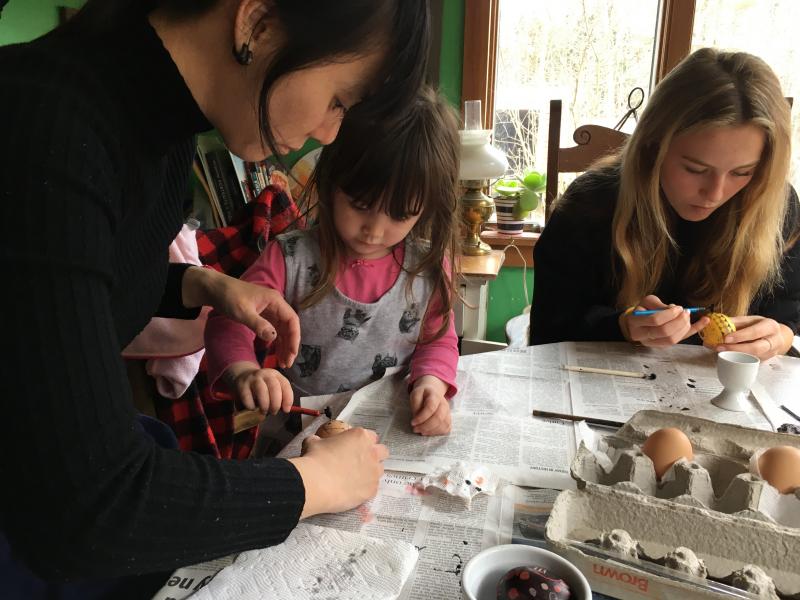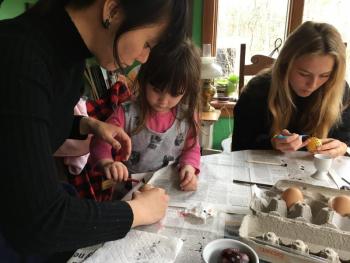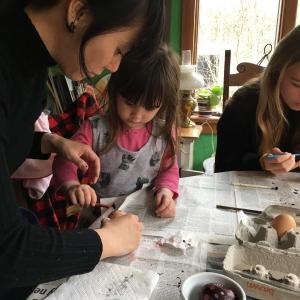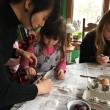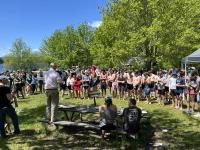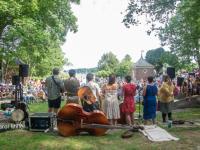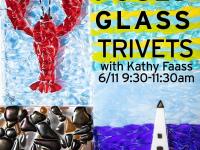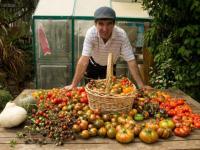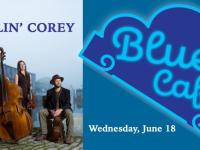This Week in Lincolnville: Pysanky Season
It was my granddaughters who prompted me to bring out the Pysanky egg decorating gear this year: the kistkas, beeswax and candle stubs, the one-hole egg blower, the jars of two-year-old dye. It had been that long since we’d gathered around the kitchen table for an afternoon of drawing on fragile, empty egg shells with melted wax.
My first response was “YES! Of course!” and then the second thought: oh, of course – Ukraine.
With that devastated country on our minds – always somewhere in our thoughts, day-long and even in our sleep – Pysanky, I learned while writing this morning (thank you Wikipedia), was traditionally made during the last week of Lent, made by the women in the family.
During the middle of the Lenten season (the 40 days before Easter) the “women began putting aside eggs, those that were most perfectly shaped and smooth, and ideally, the first laid eggs of young hens. There had to be a rooster, as only fertilized eggs could be used. (If non-fertile eggs were used, there would be no fertility in the home.)
They made the decorated eggs at night after the children were asleep and in secret. Patterns and colors were passed down in a family, mother to daughter. The patterns were often symbolic; again, go to Wikipedia for a tutorial in the symbols that were incorporated into the design of a Pysanky egg.
CALENDAR
MONDAY, April 11
Recreation Committee, 4 p.m., Town Office
Selectmen, 6 p.m., LCS
TUESDAY, April 12
Library open, 3-6 p.m., 208 Main Street
Broadband Committee, 6 p.m., Town Office
WEDNESDAY, April 13
Library open, 2-5 p.m., 208 Main Street
THURSDAY, April 14
Conservation Committee, 4 p.m., town Office
Budget Committee, 6 p.m., Town Office
FRIDAY, April 15
Library open, 9-noon, 208 Main Street
Early Release for LCS, 11:30 a.m.
SATURDAY, April 15
Library open, 9-noon, 208 Main Street
SUNDAY, April 16
Easter Services at Bayshore and United Christian Churches (see article for times.)
EVERY WEEK
AA meetings, Tuesdays & Fridays at noon, Community Building
Lincolnville Community Library, For information call 706-3896.
Schoolhouse Museum by appointment, 505-5101 or 789-5987
Bayshore Baptist Church, Sunday School for all ages, 9:30 a.m., Worship Service at 11 a.m., Atlantic Highway
United Christian Church, Worship Service 9:30 a.m., 18 Searsmont Road or via Zoom
This ancient ritual of decorating the eggs of young, fertile hens still resonates in today’s modern world when spring begins emerging all around us. A spring today that’s being obliterated in the very birthplace of the practice.
And it had been at least two years since the annual community Pysanky party was held at the Community Building. Long-time Lincolnville resident Julie Turkevich organized the day, enlisting friends to cover the floor with plastic under the dye table, set up enough supplies for the 30 or so people who might come – the above-mentioned kistkas, etc. –- and for inspiration, a table of the previous year’s work and books of designs.
Of course, since this is Lincolnville there was food: cookies, sandwiches, the usual fodder to sustain us all.
Families came, some every year, folks who’d never done it along with the old hands who helped the young ones and newcomers. The chance to fiddle around with fire and melted wax along with permanent dyes was irresistible for certain little boys. I wonder how many folks in town were inspired to collect their own supplies this year, remembering Julie’s Pysanky party.
Fortunately, I found in my little box labelled “Pysanky” ten tiny packets of dye, a gift from Julie who moved to Vermont this winter. I poured out the old dyes, which tend to deteriorate over time, and mixed up ten new jars. This dye isn’t food-safe, unlike the little tablets you get in Easter egg dyeing kits, so you can’t eat eggs dyed with it.
Traditionally, the eggs were decorated raw; over time the innards dry out. I’ve done them that way and can say it’s a bit risky. After Easter is over and the eggs are packed away, you can get a surprise, say on a hot August day when there’s a strange POP! coming from the back of the cupboard, followed by a foul smell. One of your lovely Pysanky creations has just exploded.
Blowing out the contents of the egg with a clever little device that pumps air into the egg via a tiny hole, forcing the white and yolk to pour out, leaves a nice clean egg shell. It won’t explode but is so fragile that at least once during the day somebody’s beautiful egg rolls off the table onto the floor. And more than once tears ensue.
The process is counter-intuitive. You draw a design in melted wax on the white egg with a kitska, a “pen” that has a tiny reservoir for beeswax. It’s slow work, as you hold the kitska over a candle flame to melt the wax, draw a bit on your egg, then heat it up again.
Now dip the egg in dye, usually starting with the lightest color, say yellow. Gently dry it off with a paper towel, then draw some more, and then into the next darkest color, maybe blue. Now you’ve got a green egg, so draw some more and dye again. Repeat until your design is done. Traditional Pysanky eggs often end up a rich black.
Somewhere on the egg write your initials and the year. I have an egg dated 1984 made by my then 12-year-old.
Holding the heavily-waxed egg by its ends near the side of the candle flame (not over it!) wipe off the wax as it melts with a paper towel. This is the fun part as the design you’ve made emerges – the first lines you made are white, then next are yellow, and so on until all the wax is removed.
When Julie and her husband, Allan, moved away a few weeks ago she left most of her collection of eggs behind with instructions to give them away, especially to those who participated in the Pysanky party.
Apparently giving them away is part of the tradition. Here’s what those Ukranian women did with the 60 or so eggs they might decorate in the week before Lent:
1. One or two would be given to the priest.
2. Three or four were taken to the cemetery and placed on graves of the family.
3. Ten or 20 were given to children or godchildren.
4. Ten or twelve were exchanged by the unmarried girls with the eligible men in the community.
5. Several were saved to place in the coffin of loved ones who might die during the year.
6. Several were saved to keep in the home for protection from fire, lightning and storms.
7. Two or three were placed in the mangers of cows and horses to ensure safe calving and colting and a good milk supply for the young.
8. At least one egg was placed beneath the bee hive to ensure good production of honey.
9. One was saved for each grazing animal to be taken out to the fields with the shepherds in the spring.
10. Several were placed in the nests of hens to encourage the laying of eggs.
Pray for Ukraine, whatever form your prayers take.
Town
In an effort to promote more interest in town affairs and perhaps getting involved by joining a town committee, there are now multiple ways to attend a selectman’s meeting, either in person or remotely; it’s a good way to start. The agenda the April 11 Selectman’s meeting has two links to make it easier than driving out to the town office. One is to livestream and another is to attend via zoom . You can also watch the meeting live on cable, Channel 22.
School
This week’s Lynx newsletter presents several programs for kids this spring from T-ball for youngsters to outdoor art classes for 7 and 8th graders and more in between. Check it out.
Easter
Bayshore Baptist Church will be holding it’s traditional sunrise service at Lincolnville Beach at 6 a.m. Easter morning, followed by breakfast (free) at the church. All are welcome! If you want to see the actual sunrise, come early....5:49 a.m. to be exact. Regular 9 a.m. Sunday school and 11 a.m. worship service will be held as well.
United Christian Church holds its in-person service at 9:30 a.m. Easter as well as on Zoom.

